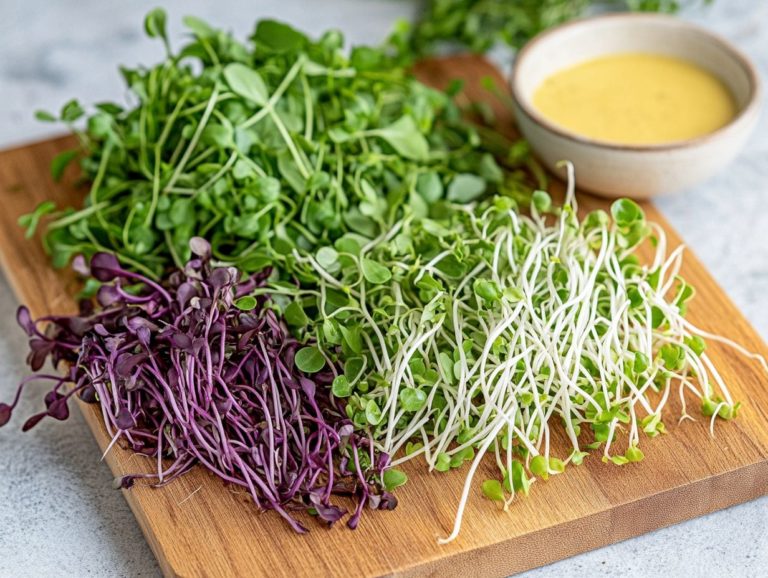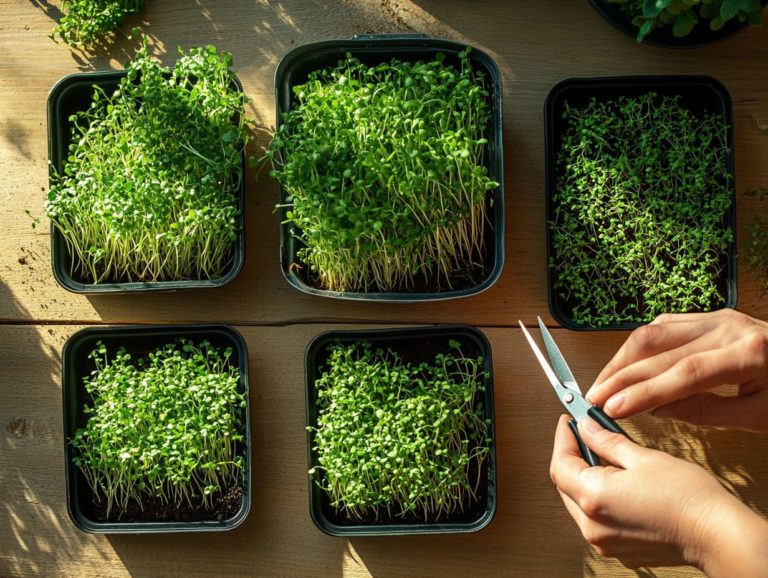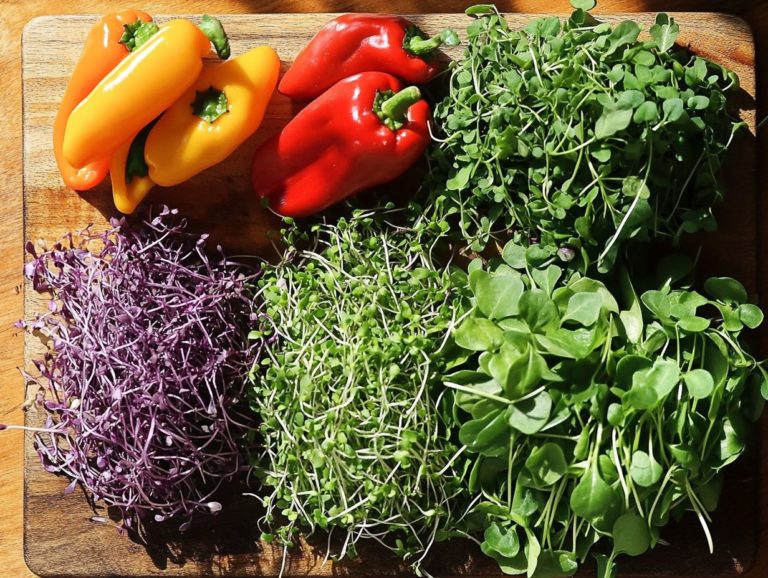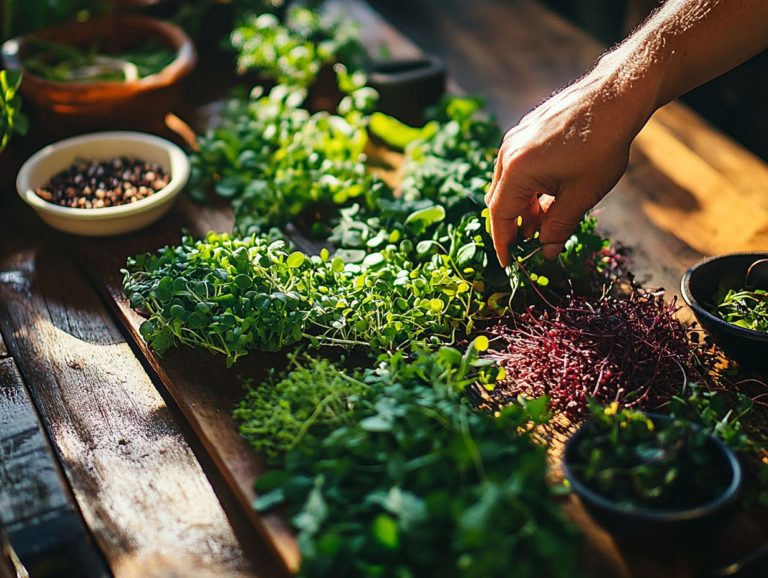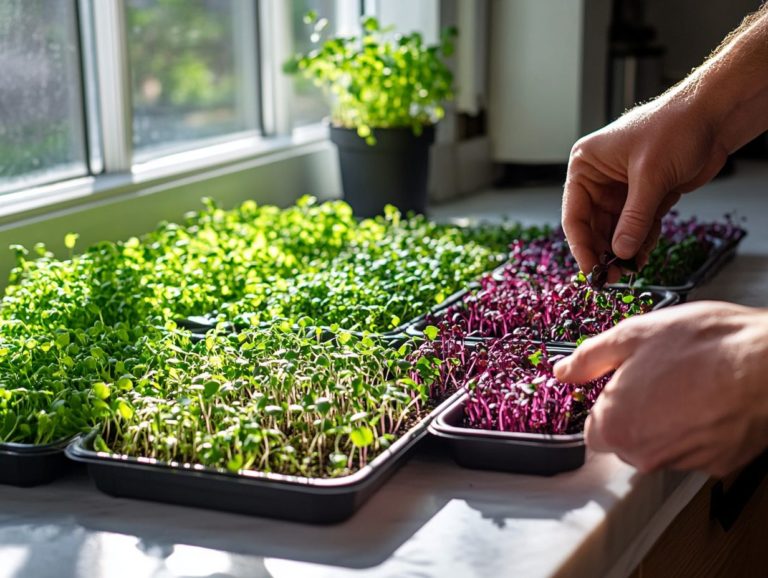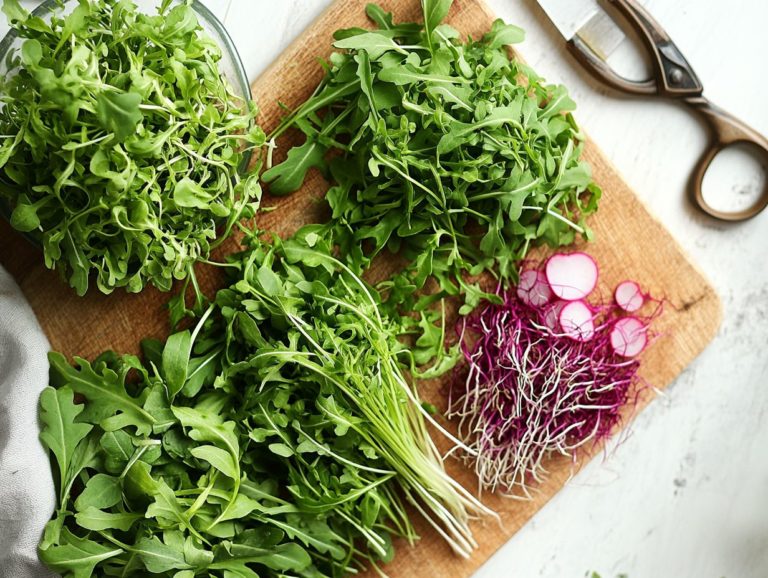Best Microgreen Varieties for Beginners
Microgreens have captivated both home cooks and health enthusiasts alike, offering intense flavors and a wealth of nutrients packed into those tiny greens.
If you’re curious about how to cultivate these plants in your own home, this guide is tailored just for you. You’ll discover everything from selecting the best seeds for growth to exploring popular varieties such as sunflower shoots and radish microgreens.
You will also find valuable tips on harvesting, storing, and incorporating these delightful greens into your meals. Get ready to dive into the exciting world of microgreens!
Contents
- Key Takeaways:
- 1. What Are Microgreens and Why Are They Popular?
- 2. How to Grow Microgreens at Home
- 3. Choosing the Right Seeds for Beginners
- 4. Top 5 Microgreen Varieties for Beginners
- 5. Sunflower Shoots
- 6. Radish Microgreens
- 7. Pea Shoots
- 8. Broccoli Microgreens
- 9. Cilantro Microgreens
- 10. How to Harvest and Store Microgreens
- 11. Common Mistakes to Avoid When Growing Microgreens
- 12. Tips for Success with Microgreens
- 13. Health Benefits of Microgreens
- 14. Creative Ways to Use Microgreens in Meals
- 15. Final Thoughts on Growing Microgreens as a Beginner
- Frequently Asked Questions
- What are the best microgreen varieties for beginners?
- What makes sunflower microgreens a good choice for beginners?
- Why are pea shoots and pea microgreens recommended for beginner microgreen growers?
- What are the health benefits of growing radish microgreens?
- Can beginners grow microgreens indoors?
- Are there any other easy-to-grow microgreen varieties for beginners?
Key Takeaways:
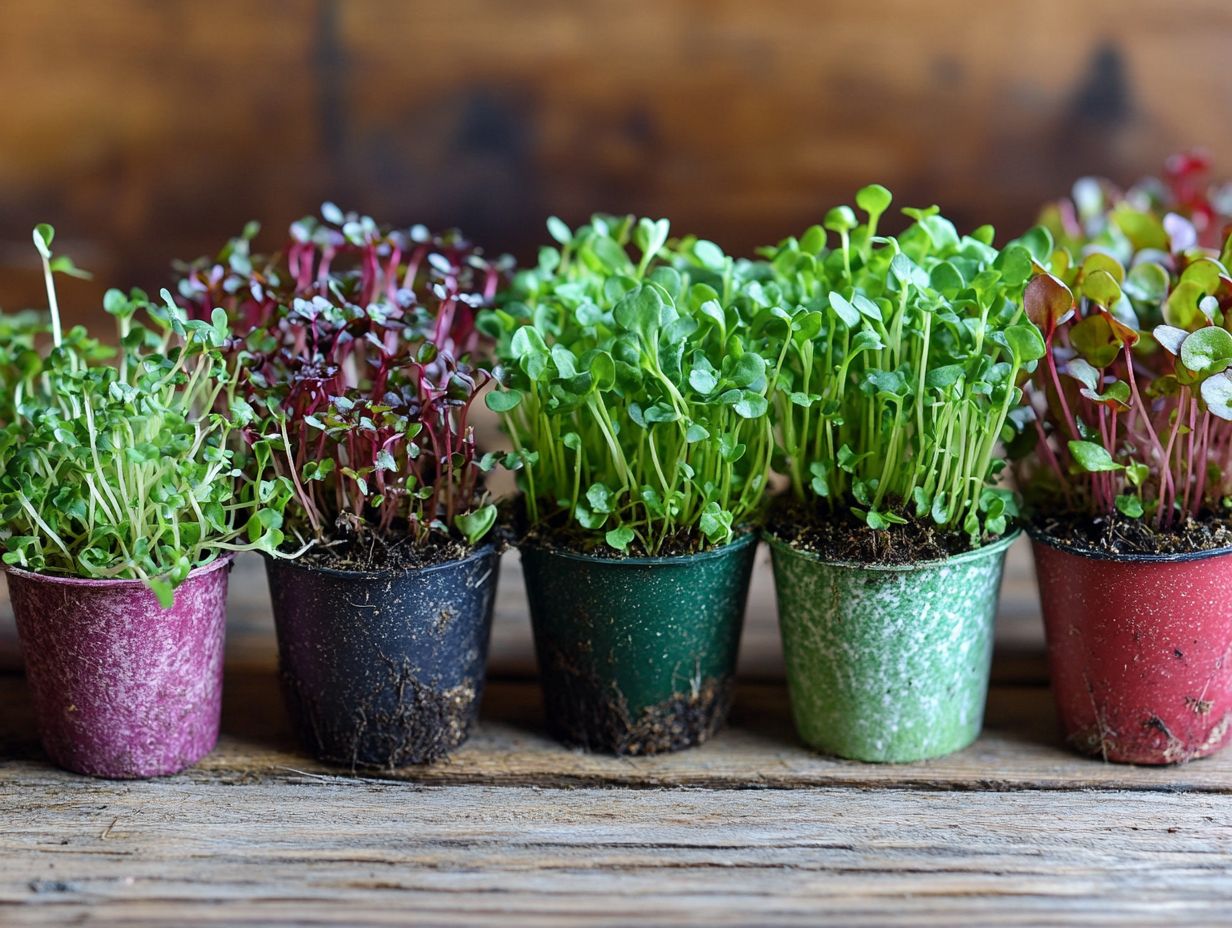
- Start with easy-to-grow seeds like sunflower, radish, and pea shoots for your microgreen garden.
- Avoid common mistakes by ensuring proper watering and sunlight for your microgreens.
- Incorporate microgreens into your meals for added nutrition and creative flavors.
1. What Are Microgreens and Why Are They Popular?
Microgreens are your go-to young, edible plants, harvested just after their first leaves unfurl. They re celebrated for their vibrant colors, unique flavors, and concentrated nutrients, making them a favorite among health-conscious consumers and cooking fans.
Their charm lies not only in their visual appeal but also in their remarkable health benefits. They boast high antioxidant levels and a rich nutritional profile. For anyone looking to boost their diet with fresh produce, they offer an easy-to-grow option that requires minimal investment and delivers quick results.
These nutrient-dense greens sprout during the transitional growth phases of various herbs and vegetables, bringing forth an explosion of flavors that range from nutty to peppery. The growing fascination with microgreens is tied to their nutritional density; they often contain more vitamins and minerals per ounce than their mature counterparts.
In the culinary realm, both chefs and home cooks are captivated by these tiny greens, drawn not only to their health perks but also to their ability to elevate the presentation and flavor of dishes.
Whether you sprinkle them on a salad, blend them into smoothies, or use them as a garnish, microgreens are redefining meals! They offer both visual delight and a wealth of health advantages.
2. How to Grow Microgreens at Home
Growing microgreens at home is a straightforward and rewarding endeavor. You can use different methods, whether it s soil mixtures or growing plants in water without soil. These approaches create optimal conditions for a range of delightful varieties, from cilantro to basil. The secret to success lies in managing moisture levels and ensuring your plants receive adequate light exposure.
Start by selecting seeds that align with your taste preferences or the nutrients you re after. If you re opting for a soil mixture, fill your trays with a suitable blend, making sure it s evenly distributed and lightly pressed down. For hydroponic systems, you’ll need a nutrient-rich solution, which you should monitor closely to maintain ideal pH levels.
Keep a close eye on moisture content bottom watering works wonders by encouraging root growth without drowning your seedlings. And let s not forget about light: it s essential. Position your trays in a spot that gets plenty of sunlight, or use grow lights for 12-16 hours daily. This will promote robust growth and those vibrant colors you re after in your microgreens.
3. Choosing the Right Seeds for Beginners
For you, selecting the right seeds is key to ensuring a successful microgreens growing experience. Understanding factors like seed quantity, germination time, and trustworthy suppliers can truly make a difference.
By opting for beginner-friendly varieties such as radish microgreens, basil, or arugula, you simplify the process and set yourself up for a rewarding yield. For more tips on choosing the right microgreen seeds to launch your indoor gardening adventure, explore the options available.
When choosing your seeds, it’s essential to pay attention to germination time. Quick-germinating varieties allow for faster turnarounds, offering you a sense of accomplishment and motivation as you embark on your journey as a novice grower.
Sourcing seeds from reputable suppliers is equally important. Quality seeds directly influence the health and flavor of your microgreens. When you choose quality, you re more likely to achieve consistent results and minimize the risk of frustrating failures that can dampen your enthusiasm.
Select seeds known for their ease of growth and vibrant flavors. You can cultivate a flourishing microgreen garden by exploring microgreen varieties: a guide for beginners that not only nourishes your passion but also excites your taste.
4. Top 5 Microgreen Varieties for Beginners
When you embark on your microgreens journey, certain varieties will emerge as ideal choices for beginners. Consider radish microgreens, cilantro, basil, arugula, and mustard greens each a delightful addition, offering distinctive flavors and ease of growth.
These microgreen varieties pack a flavor punch for your culinary creations and are loaded with impressive nutritional benefits. Exploring the benefits of growing diverse microgreen varieties can enhance your indoor gardening endeavors.
Radish microgreens, with their peppery bite, can elevate salads and sandwiches. Cilantro brings a fresh zest to various cuisines. Basil microgreens, with their sweet aroma, enhance Italian dishes beautifully, while arugula introduces a mild, nutty flavor that pairs perfectly with pastas and pizzas. If you’re looking to diversify your garden, check out this guide on how to choose microgreen varieties for your garden. Mustard greens deliver a spicy kick that can dress up any stir-fry or grain bowl.
Together, these options simplify the growing process due to their minimal care requirements while maximizing your nutritional intake. They enrich your diet with vitamins and antioxidants that support overall wellness, making your microgreens journey both rewarding and delicious.
5. Sunflower Shoots
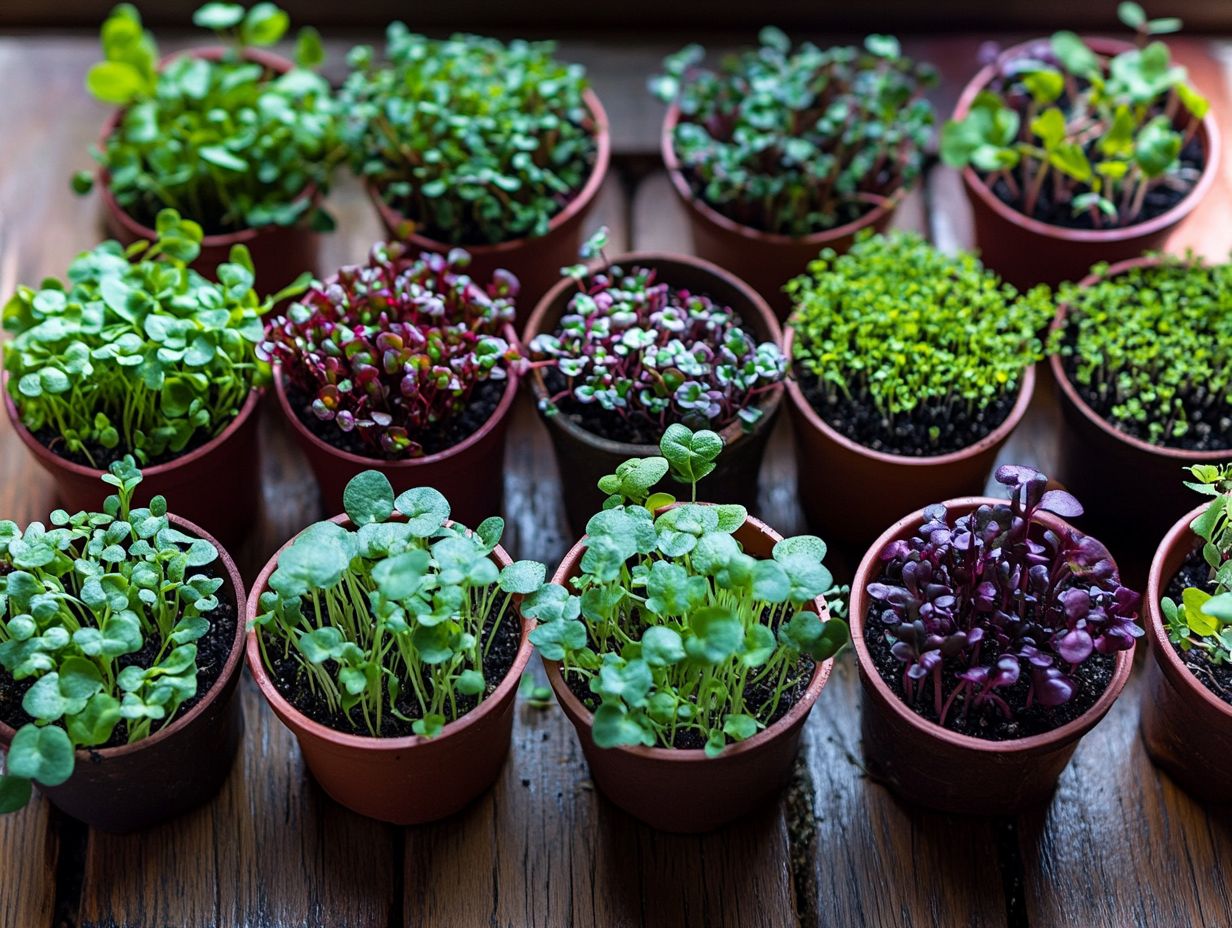
You ll love sunflower shoots for their vibrant colors and crunchy texture, making them a favorite among health enthusiasts and culinary creatives.
These tender greens are loaded with essential vitamins like A, C, and E, along with minerals such as calcium and iron, all contributing to your overall wellness.
Incorporating sunflower shoots into your meals enhances flavor and adds a visually striking element to your plates, transforming even the simplest dishes into beautiful dishes.
Their subtle nutty taste pairs beautifully with colorful salads, hearty grain bowls, or as a sophisticated garnish on soups. Growing sunflower shoots at home is easy and rewarding! With their impressive nutrient profile and versatility in the kitchen, sunflower shoots are truly a nutritious powerhouse that elevates both your plate and your palate.
Get started on your microgreens journey today!
6. Radish Microgreens
Radish microgreens are a delightful choice for your culinary adventures, celebrated for their peppery flavor and rapid growth. If you’re looking to enjoy a quick turnaround in your microgreen gardening, these little greens are perfect. They also offer many health benefits. Packed with rich nutrients, they can enhance any dish, making them a staple whether you re cooking gourmet meals or everyday fare.
These vibrant greens thrive in well-drained soil and only need a few days of sunlight to flourish. This makes them ideal for gardeners of all skill levels. Their distinct flavor can elevate salads, sandwiches, and soups, adding a zesty kick while delivering essential vitamins and antioxidants.
Rich in vitamin C, fiber, and other beneficial compounds, incorporating radish microgreens into your meals not only boosts flavor but also supports your overall health. Whether you sprinkle them atop avocado toast or blend them into a smoothie, these tiny powerhouses adapt seamlessly to various culinary creations. They prove that even the smallest ingredients can make a significant impact in your kitchen.
7. Pea Shoots
Pea shoots are a delightful microgreen variety, celebrated for their sweet, distinctive flavors and tender texture. This makes them a go-to choice for both chefs and home cooks. Rich in health benefits and nutrients, these microgreens can elevate a range of dishes. They infuse meals with flavor and nutrition while being remarkably easy to grow indoors.
After just a few weeks of nurturing from seeds, you’ll enjoy their fresh, lush green tops. They add a vibrant touch to salads, sandwiches, and stir-fries. These versatile shoots not only enhance the visual appeal of your meals but also provide a delightful crunch and a mild sweetness that complements various cuisines. For more information, check out this quick guide to common microgreen varieties.
Packed with vitamins A, C, and K, along with a healthy dose of antioxidants, pea shoots support overall well-being. They boost your immunity and promote vitality. Incorporating them into your meals offers essential fiber, making pea shoots an exceptional choice for anyone looking to naturally enhance their diet.
8. Broccoli Microgreens
Broccoli microgreens are celebrated for their remarkable antioxidant levels and rich nutrients. They position themselves as a true powerhouse of health benefits in a compact form. Not only do these microgreens deliver a mild yet distinctive flavor, but they also elevate a variety of culinary dishes. They promote your overall well-being while being a seamless choice for anyone venturing into indoor gardening.
Packed with vitamins A, C, E, and K, along with essential minerals like calcium and iron, these tiny greens can significantly enhance your nutrient intake. Their culinary versatility allows you to incorporate broccoli microgreens into salads, sandwiches, smoothies, and garnishes. They effortlessly transform simple meals into nutrient-dense delights.
Growing them demands minimal space and can be easily accomplished indoors with just a few basic materials. This makes it accessible for anyone eager to boost their diet with fresh, vibrant produce. With their rapid growth cycle, you’ll find that with a touch of patience, you can start reaping the benefits of the best microgreens for nutritional value in just a matter of days.
9. Cilantro Microgreens
Cilantro microgreens are a delightful addition to your culinary repertoire. They infuse a burst of fresh flavor that can elevate a wide range of dishes, from crisp salads to zesty salsas. These tiny greens not only enhance your meals with their unique taste, but they also come loaded with essential nutrients. This makes them an ideal choice for those who prioritize health without sacrificing flavor.
Their distinct taste, marked by a refreshing citrusy zest, pairs beautifully with an array of ingredients. It enriches everything from comforting soups to vibrant tacos and grain bowls. Both chefs and home cooks recognize how these petite wonders can transform simple recipes into culinary masterpieces. Nutrition enthusiasts revel in their impressive levels of vitamins A, C, and E, along with valuable antioxidants.
This perfect harmony of flavor and health benefits establishes cilantro microgreens as an essential kitchen staple. They remind you that even the smallest additions can create a remarkable impact on both taste and nutrition.
10. How to Harvest and Store Microgreens
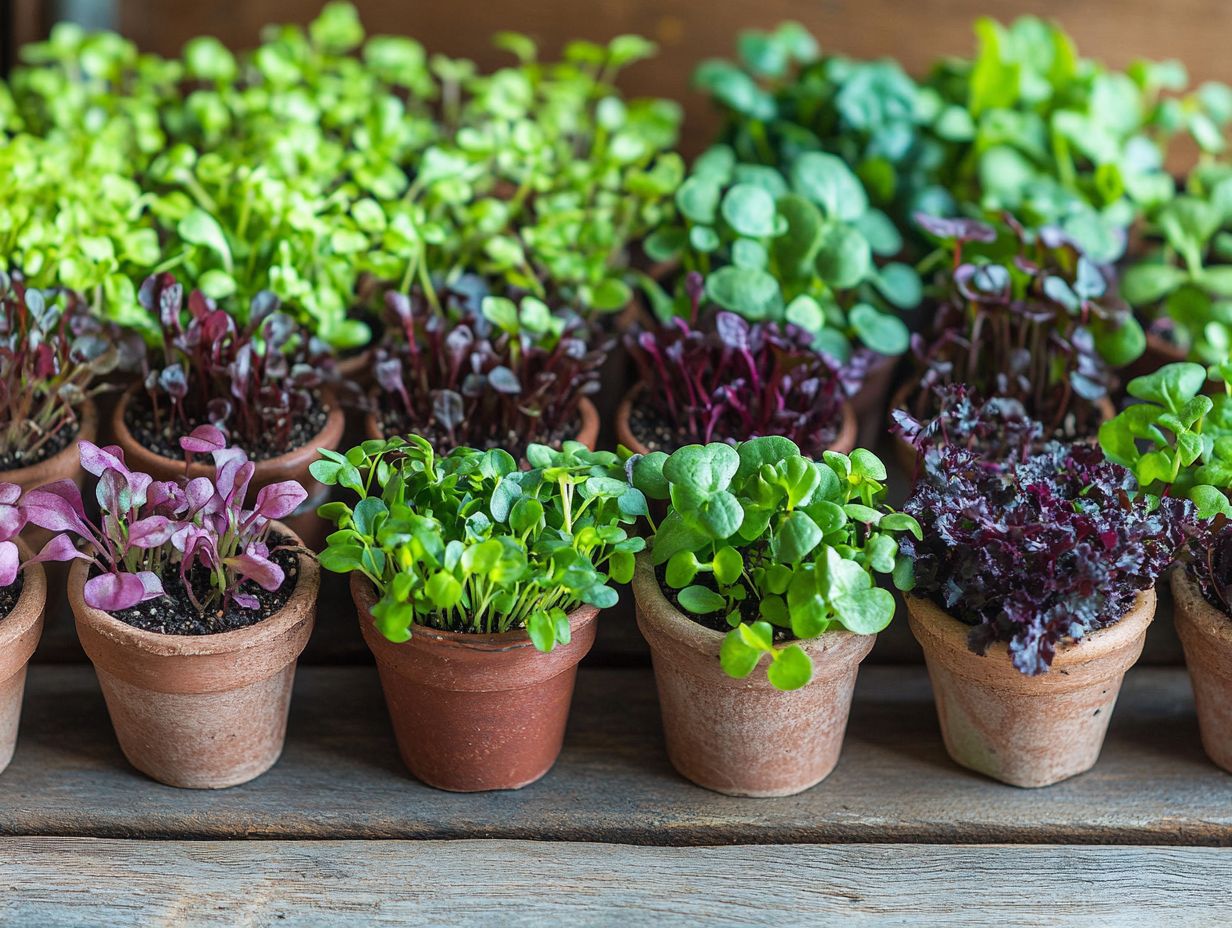
Harvesting and storing microgreens with care is essential for maintaining their freshness and nutritional value, ensuring that you fully enjoy the fruits of your indoor gardening efforts. By using the right methods like using clean scissors for harvesting and storing them in places that control moisture you can preserve the vibrant colors and unique flavors of your microgreens, whether they re grown in trays or hydroponically.
Consider harvesting in the early morning when the moisture levels in the leaves are at their peak. This timing allows for a crisp texture that truly enhances the flavor. After cutting, place your microgreens in a breathable container lined with a damp paper towel to prevent wilting. If you plan to store them for several days, keep them in the refrigerator, ideally in a container that minimizes excess moisture.
This meticulous attention to moisture and temperature not only extends shelf life but also ensures your microgreens look and taste their absolute best, transforming each bite into a delightful experience.
11. Common Mistakes to Avoid When Growing Microgreens
New growers often find themselves caught up in common mistakes that can stall their microgreens’ success, like improper moisture levels and inadequate growing conditions, ultimately leading to less-than-stellar yields. Recognizing these pitfalls is crucial for you as a beginner, enabling you to optimize your growing experience and savor the health benefits and vibrant flavors that microgreens provide.
One frequent issue you might face is maintaining the right moisture levels. Too much water can invite mold, while too little can stunt your plants’ growth. Many new growers underestimate how important lighting is, often placing their trays in spots that lack sufficient natural light. To avoid these setbacks, consider investing in quality grow lights to ensure your plants bask in adequate illumination for at least 12 to 16 hours a day.
Using a simple moisture meter can help you keep tabs on soil dampness, striking that perfect balance for thriving microgreens. Adopting these practices will enhance your harvest and deepen your appreciation for the art of microgreen cultivation.
12. Tips for Success with Microgreens
To thrive with microgreens, pay close attention to details and commit to best practices. Selecting the right soil mixture and managing moisture levels effectively are essential steps in this journey. By embracing expert tips tailored for indoor gardening, you can not only maximize your yield but also revel in the numerous health benefits these vibrant plants offer.
Choosing the right soil mixture is a game-changer for your garden! A blend featuring compost, coconut coir, and perlite often delivers outstanding results. Balancing moisture management is equally vital; ensuring the soil is neither too dry nor overly saturated prevents mold and fosters healthy growth.
Creating optimal growing conditions is key. A well-lit area with a consistent temperature around 70 F can significantly boost germination rates. By diligently monitoring these factors, you’ll create a lush microgreen garden that overflows with flavor and nutrition, ultimately reaping a bounty of nutritious and flavorful greens. For those interested in expanding their garden, exploring seasonal microgreen varieties for year-round growth can provide great options.
13. Health Benefits of Microgreens
Microgreens are more than just a culinary treat; they are a powerhouse of health benefits that enhance any diet. Packed with concentrated nutrients and antioxidants, these tiny greens contribute significantly to your overall well-being by providing essential vitamins and minerals that support a healthy lifestyle.
Harvested just days after germination, microgreens have an impressive nutritional profile compared to their mature counterparts. Take kale and broccoli microgreens, for example; they’re known for their cancer-fighting properties. Then, there’s arugula, which is a robust source of vitamins A, C, and K, crucial for boosting immune function and maintaining bone health. If you’re interested in growing your own, check out this guide to grow microgreens for beginners.
The vibrant colors of these microgreens signal the presence of various phytonutrients, which are substances in plants that help fight diseases and combat oxidative stress in your body. By incorporating these nutrient-rich greens into your meals, you not only enhance flavors but also easily increase your vegetable intake, supporting a balanced diet and promoting long-term wellness.
14. Creative Ways to Use Microgreens in Meals
Microgreens offer a world of culinary possibilities, serving as a vibrant and nutritious addition to everything from simple salads to gourmet creations. Embracing their unique flavors and striking colors can elevate your cooking experience, providing a health boost while enhancing the visual appeal of your meals.
These tiny greens can completely transform your meals, bringing delightful textures and tastes that turn the ordinary into the extraordinary. Whether you sprinkle them atop soups for a fresh finish or blend them into smoothies for an extra nutrient kick, the versatility of microgreens is remarkable. To explore different options, check out the microgreen varieties: taste and flavor guide. Adding them to your culinary repertoire enhances flavor profiles and makes even the simplest recipes burst with freshness.
From the peppery bite of arugula to the delicate sweetness of pea shoots, these mini marvels not only add a splash of color to your plate but also deliver essential vitamins and minerals that support a health-conscious lifestyle.
15. Final Thoughts on Growing Microgreens as a Beginner
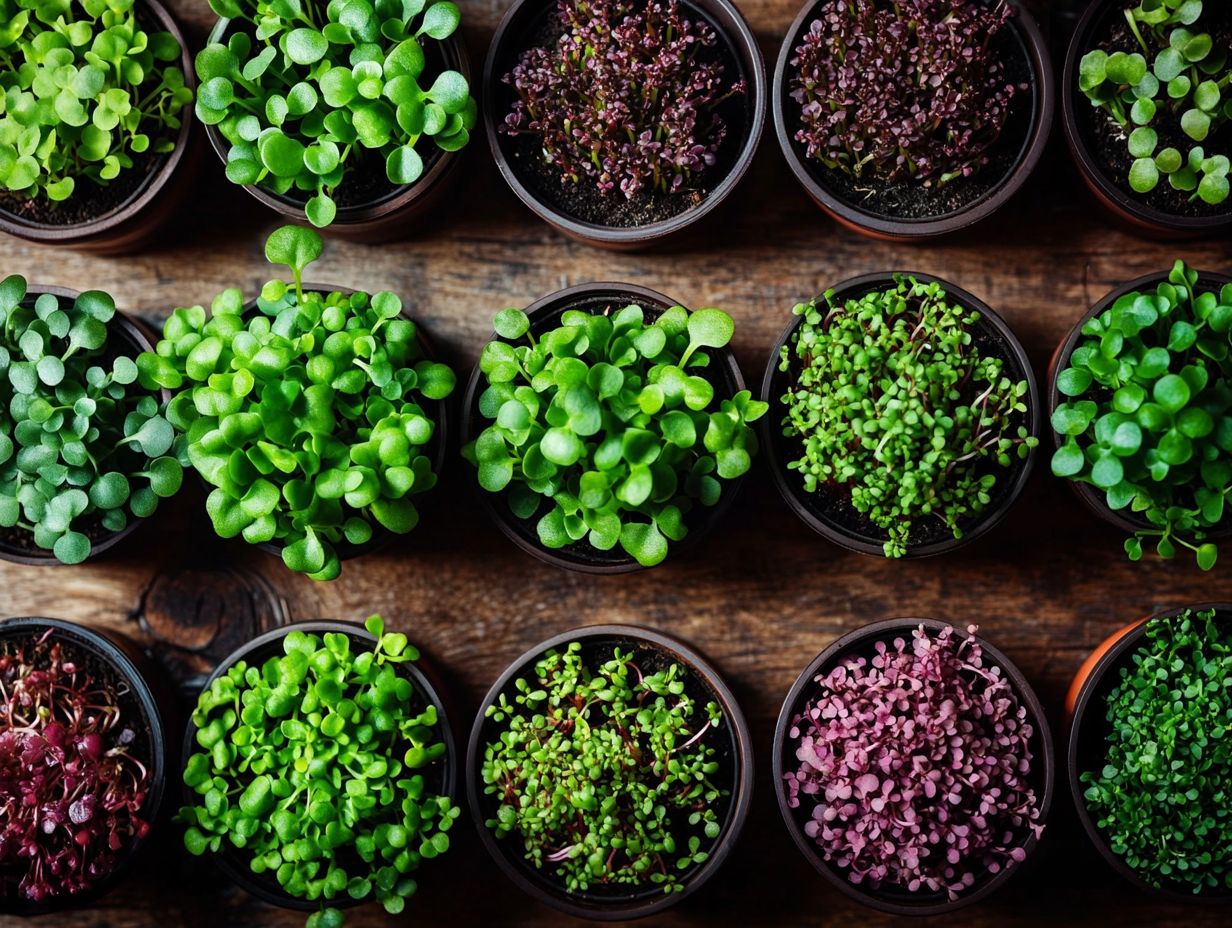
Growing microgreens as a beginner can be a rewarding journey, offering the joy of nurturing plants and the health benefits of these nutrient-rich greens. With a basic understanding of the growing process and the right resources, you can cultivate a thriving microgreen garden indoors, transforming your relationship with fresh produce and cooking.
Your journey begins with selecting the right seeds, such as radish, arugula, or mustard, which are celebrated for their rapid growth and bold flavors. Using simple containers and quality soil, you’ll watch these tiny plants flourish in just days. If you’re new to this hobby, check out how to start a microgreen garden for beginners. This process not only elevates your culinary creations but also fills your plate with essential nutrients like vitamins A, C, and K, making it a smart investment in your health.
Embracing indoor gardening opens a world of sustainability and freshness, allowing you to enjoy the fruits of your labor while enhancing your cooking adventures.
Frequently Asked Questions
What are the best microgreen varieties for beginners?
Some of the best microgreen varieties for beginners include sunflower, pea shoots, radish, and broccoli. These varieties are easy to grow, have mild flavors, and provide many health benefits.
What makes sunflower microgreens a good choice for beginners?
Sunflower microgreens are a great option because they grow easily, taste nutty, and are packed with important nutrients such as vitamin E and folate.
Why are pea shoots and pea microgreens recommended for beginner microgreen growers?
Pea shoots and pea microgreens are recommended for beginners because they are fast-growing, require minimal maintenance, and have a fresh, sweet flavor.
What are the health benefits of growing radish microgreens?
Radish microgreens are packed with antioxidants, vitamins, and minerals. This makes them an excellent choice for anyone wanting to boost their nutrition!
They have a spicy flavor that adds a kick to dishes.
Can beginners grow microgreens indoors?
Yes! Beginners can easily grow microgreens indoors in different ways. They require minimal space and can be grown in containers or garden trays.
These plants only need a few hours of sunlight each day, making them perfect for those with limited outdoor space.
Are there any other easy-to-grow microgreen varieties for beginners?
Absolutely! Other easy-to-grow varieties include broccoli, kale, and amaranth. These plants are delicious and highly nutritious, with mild flavors that enhance various recipes.

